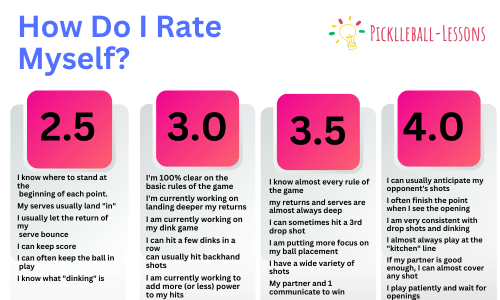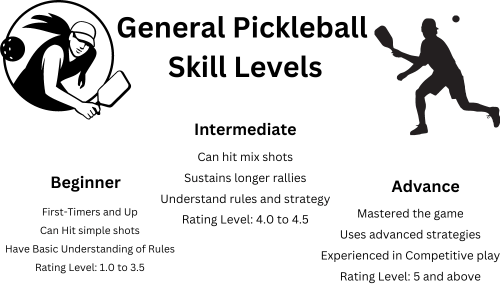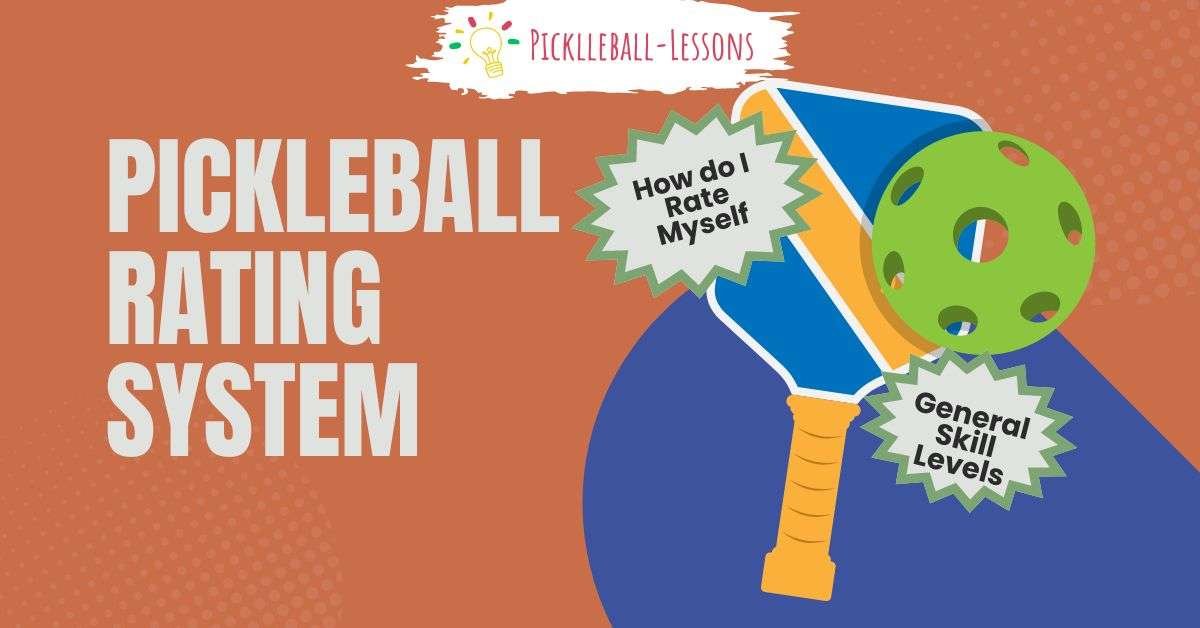Pickleball ratings decide where you stand in the game. Think of it as a scale from 1.0 to 6.0, where 1.0 is for beginners who are just picking up a paddle, and 6.0 is for the pros who compete nationally and have skills that wow. Your rating affects who you play with and against, influencing both the challenge and fun levels of your games. It’s not just a number; it’s a guide to help you find the right opponents and teammates, making sure games are competitive but enjoyable. This system is essential because it steers your game strategy. Knowing your rating and those of your opponents lets you anticipate the game’s pace and style. No surprises, just strategy. So, getting a grip on this system will not only place you correctly but also shape how you play and grow in pickleball.

Understanding the Basics of Pickleball Ratings
Pickleball ratings might seem just like numbers, but they’re your key to unlocking better games. These ratings range from 1.0 to 6.0, showing how skilled players are. Beginners start at 1.0, while pros are up at 6.0. Your rating decides who you play against and helps in finding matches that are fair and challenging. It’s not just about pride; it’s practical.

When you know your rating, you pick tournaments and leagues that fit you best. So, if you’re a 3.5 and you play against a 4.0, expect a tough match, but it’s a chance to push your limits. And if you’re aiming to improve, going against higher-rated players shows you where you need to level up your game. Remember, your rating isn’t set in stone. Play more, learn from each game, and your rating will climb. This simple number can guide your training focus, match strategy, and even whom you team up with in doubles. Keep it in mind next time you hit the court.
How Ratings Affect Matchmaking in Tournaments
In pickleball tournaments, your rating is like your secret weapon or your Achilles’ heel—it deeply influences who you’re up against. Think of your rating as a snapshot of your skills, ranging from 1.0 (just starting out) to 5.0+ (top-tier players). When you sign up for a tournament, organizers use this number to pair you with or pit you against players of similar skill levels.
This means if you’re rated 3.5, you’ll match up with players in that neighborhood—neither beginners nor the seasoned pros. It’s a way to keep matches fair and fun, pushing you just enough without feeling outmatched or out of depth. Why does this matter? Because it shapes your game strategy. Knowing the skill level of your opponents, you can tailor your practice and focus. If you’re on the lower end of your rating bracket, you might work on defensive plays to hold your own against slightly stronger players. Floating at the top? Maybe you’ll fine-tune your aggressive shots to dominate. Either way, your rating not only decides who you face but also guides how you prepare. So, keep an eye on it, work on your weaknesses, and use it to your advantage. In pickleball, strategy starts long before you step on the court.
The Role of Ratings in Goal Setting and Motivation
Your pickleball rating is more than just a number—it’s a tool that shapes your entire game strategy. Whether you’re a beginner or have been hitting the courts for years, understanding your rating helps set clear, achievable goals. These goals aren’t just about winning more matches; they’re about personal growth and improving specific parts of your game. Imagine aiming to move from a 3.0 to a 3.5 rating. This isn’t just about scoring points. It’s about mastering a new serve, improving your backhand, or becoming more strategic in your play.
Ratings also fuel motivation. Each time you level up, it’s a tangible sign of your hard work paying off. This motivates you to keep pushing, to keep improving. It’s not just about the brag factor of saying “I’m a 4.0 now.” It’s about the satisfaction of seeing your efforts translate into real, measurable progress. Plus, knowing where you stand can help you find the right partners and opponents. You’ll be challenged just enough to grow, without feeling overwhelmed or underwhelmed by the competition. So, your rating? It’s a guidepost, a motivator, and a matchmaker, all rolled into one.
Strategy Adjustments Based on Your Current Rating
Understanding your pickleball rating helps shape your game strategy. If you’re rated lower, focus on mastering the basics—serving, returning, and keeping the ball in play. It’s about building confidence. At this level, aggressive shots might not be your friend. Instead, play it safe, aim for consistency, and gradually introduce more complex strategies as you improve.
As your rating improves, start pushing your boundaries. Introduce spin shots, work on your placement, and experiment with different tactics like dinking or power plays. Higher-rated players often have a deep toolbox of strategies they can pull from. They adjust their play based on their opponent’s weaknesses. If you’re up there, strategy becomes more nuanced. You’ll need to read the game, anticipate your opponent’s moves, and sometimes, switch tactics mid-game.
No matter your rating, always remember: adaptability is key. Your rating provides a map, but it’s up to you to navigate the terrain ahead.
Training Focus: Improving Weak Areas Highlighted by Your Rating
Your pickleball rating uncovers your gameplay strengths and weaknesses. Seeing a lower rating in certain areas isn’t a setback but a map to guide your training. If your serve earns low points, dedicate more time to practice it. Weak in strategy? Watch pro matches, learn from them. This approach turns your weak spots into strengths, raising not just your rating but also your game confidence. Aim to balance your skills across the board; it makes you unpredictable and tougher to beat. So, use your rating as a tool, not a verdict. Embrace focused training to transform your game.
The Psychological Impact of the Pickleball Rating System on Players
The pickleball rating system can really mess with your head. When you know your number, it’s like carrying a badge that tells everyone how good you are—or aren’t. This tiny number starts to shape how you see yourself and your game. Players with higher ratings might feel the pressure to live up to them, playing more conservatively to avoid mistakes. On the flip side, lower-rated players might think they’ve got nothing to lose and take risks they wouldn’t otherwise consider. It’s this mental game, beyond just skills and strategies, that influences how players approach each match. Getting too wrapped up in these ratings can steer you away from focusing on improvement and enjoying the game. Remember, it’s a system designed to help match players of similar abilities, not a measure of your worth on or off the court.
Using Your Rating to Choose the Right Competitions
Knowing your pickleball rating sharpens your competitive edge. Think of it not just as a number, but as a roadmap guiding you to the tournaments where you stand to gain the most – not just in terms of wins, but experience, growth, and fun.
Here’s the deal: playing in a competition that matches your skill level means you’ll face challengers who push you just enough. Too easy, and you won’t grow. Too hard, and it’s like hitting a wall. If you’re a 3.5 player, diving into a 4.5+ tournament might sound brave, but it’s like bringing a paddle to a gunfight.
Use your rating to scout out competitions where you’ll be neither the weakest nor the strongest player. This sweet spot is where you’ll find matches that challenge you, victories that satisfy, and losses that teach rather than demoralize.
In essence, your rating is more than just bragging rights; it’s your ticket to the most rewarding path forward in your pickleball journey. Aim for tournaments that align with your rating, and watch how it positively shifts your game strategy, motivation, and overall performance on the court.
The Importance of Staying Updated on Rating Changes
Knowing your pickleball rating and keeping an eye on changes is key. It’s not just about bragging rights. Your rating affects who you play against, which tournaments you can enter, and even the strategies you’ll use on the court. Ratings range from 1.0 (just starting) to 6.0 (top-level players). As you get better, your rating climbs. This means tougher competitions and needing to sharpen your skills. Don’t sleep on your rating. Stay updated. It guides how you train, the techniques you focus on, and how you approach each game. Think of it as your roadmap in the pickleball world. Staying in the loop on rating changes keeps you competitive and ready for what’s next.
Conclusion: Leveraging Your Rating for Strategic Advantage
Understanding your pickleball rating isn’t just about knowing where you stand; it’s about using that knowledge to shape your game. If you’re rated lower, you’re likely facing opponents with similar skills. This is your chance to experiment with new techniques or strategies without the high stakes of tougher competition. For those rated higher, your focus should be on refining those winning strategies and maintaining consistency. Regardless of your rating, always aim to play with those slightly above your level. This pushes you to improve, without being so challenging it’s discouraging. Remember, your rating reflects your current skill level but doesn’t dictate your potential. Use it as a guide, not a barrier.
Information source: USA Pickleball




